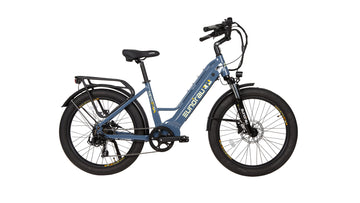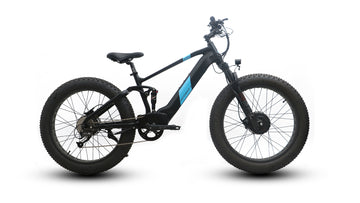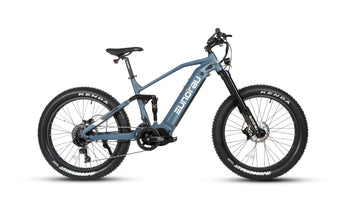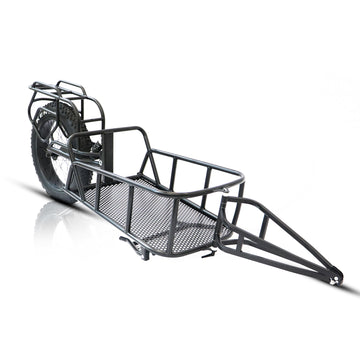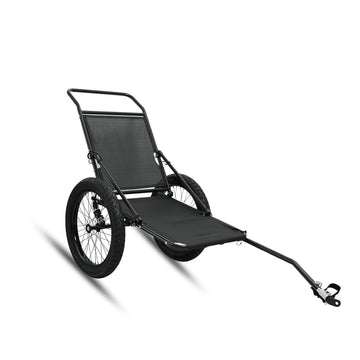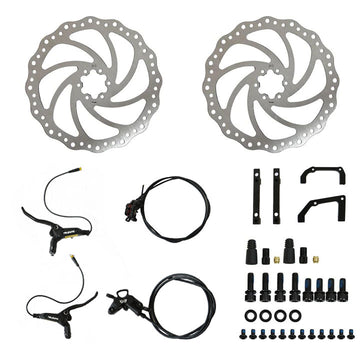
In the ever-evolving world of electric bikes, one debate still captures the attention of riders everywhere: fat tire vs. regular eBike. As 2025 brings even more innovation to the eBike space, it's important to choose the right ride that fits your lifestyle, terrain, and comfort needs. Whether you're commuting through the city or exploring backcountry trails, understanding the difference between fat tire and regular eBike options can help you make the right decision.
At Eunorau, we’ve spent years perfecting both fat tire eBikes and standard eBikes to meet the needs of diverse riders. Let’s take a deep dive into the strengths and limitations of both types of bikes, and figure out which one’s right for you.
1. What is the Difference Between a Fat Tire and a Regular eBike?
The most noticeable difference is in the tire width. Fat tire eBikes come with tires usually 4 inches or wider, while regular or standard eBikes feature tires between 1.75 to 2.5 inches. This difference in tire size leads to a dramatically different riding experience.
Fat tire bikes offer more surface contact with the ground, which translates into better traction, shock absorption, and stability. On the other hand, regular eBikes are typically lighter and more agile, making them great for urban rides and paved roads.
2. Are Fat Tire eBikes Harder to Pedal?
This is a common question we hear at Eunorau, and the answer is: not necessarily. While fat tire eBikes do have more rolling resistance than their regular counterparts, the electric motor compensates for that added effort.
In pedal-assist mode, you'll barely notice the extra resistance—especially if your bike comes with a powerful motor like our FAT-HS or DEFENDER-S. However, if you’re riding without any motor support, you may feel the effort more than on a standard eBike.
If you plan to ride often with the motor turned off or with minimal assist, a regular eBike might feel more efficient.
3. Is a Fat Tire eBike Better for Off-Road?
Absolutely. This is where fat tires shine the brightest.
Fat tires were originally designed for soft, unstable terrain. Their wide contact patch allows for better traction on:
-
Loose gravel trails
-
Muddy forest paths
-
Uneven mountain terrain
-
Rocky climbs
When paired with a full suspension system, the fat tire electric bike becomes a dream machine for off-road adventures. If you're an outdoor explorer, trail enthusiast, or weekend warrior, the fat tire vs. regular eBike debate likely tips in favor of the fat tires.
4. Can I Ride a Fat Tire eBike on the Beach or Snow?
Yes, and that’s one of the biggest pros of fat tire electric bikes.
Their wide footprint prevents the tires from sinking into soft surfaces like sand or snow, giving you access to terrains that standard eBikes can't handle.
Many Eunorau customers love taking their ebike to the beach or on snow-covered roads in winter. If you live in a region with seasonal weather changes or plan to ride in vacation areas like coastlines or ski towns, a fat tire eBike is the way to go.

5. Do Fat Tires Affect Battery Range?
Yes, and this is one of the few cons of fat tire electric bikes.
Because fat tire eBikes are generally heavier and have more rolling resistance, they consume more power to maintain the same speed as a regular eBike. This can reduce battery range slightly, depending on:
-
Rider weight
-
Terrain
-
Wind resistance
-
Tire pressure
However, Eunorau bikes are equipped with high-capacity batteries, and some models offer dual battery systems (like the FLASH with up to 220 miles of range) to offset this drawback.
If battery range is your top priority, consider how often you’ll be riding in pedal-assist vs. throttle-only mode.

6. What Size Tire Is Considered a Fat Tire?
Any eBike tire 4 inches or wider is classified as a fat tire. Some even go up to 4.8 inches, especially on performance models.
Our best-selling fat tire models come with 26” x 4.0” or 20” x 4.0” tires, providing balance between control, comfort, and capability. Regular eBikes, in comparison, stick to narrower tires in the 1.75”–2.5” range, which are great for paved or light gravel roads.
7. Are Fat Tire eBikes Good for City Commuting?
This depends on what kind of commuter you are.
If you're looking for:
-
A smooth and cushioned ride over potholes or curb transitions
-
The ability to handle occasional rough paths or snow-covered roads
-
Extra visibility thanks to a taller stance
Then a fat tire eBike can actually be an excellent commuter. Many riders are using models like the FLASH or URUS for daily rides, especially in urban/suburban areas with diverse terrain.
However, if your ride is mostly paved, flat, and over long distances, a regular eBike like the META Foldable might be more efficient due to its lighter weight and extended range.

8. Do Fat Tire eBikes Use More Power?
Yes. Wider tires, heavier frames, and all-terrain use mean that fat tire eBikes often require more energy per mile. This is one of the key considerations in the fat tire vs. regular eBike decision.
That said, fat tires distribute weight more evenly, giving you better control and safety, especially at higher speeds or on rough terrain. Many Eunorau riders find that the slightly higher power consumption is worth the versatility and comfort.
9. Pros and Cons of Fat Tire Electric Bikes
To make your decision easier, here’s a simple breakdown:
Pros:
-
Exceptional traction and control
-
Can handle any terrain: snow, sand, mud, rocks
-
Shock-absorbing comfort on uneven roads
-
More stability and safety for beginners
-
Great for adventure, off-road, or rugged commutes
Cons:
-
Heavier frame and tires
-
Slightly reduced battery range
-
More power consumption
-
May be overkill for smooth city streets
10. Choosing Your Ride Style in 2025: Fat Tire or Standard eBike?
Choose a Fat Tire eBike if you:
-
Want to ride on sand, snow, gravel, or trails
-
Prefer a comfortable, cushioned ride
-
Value control and stability over speed
-
Don’t mind a slightly heavier bike
-
Want to explore both city and off-road landscapes
Choose a Regular / Standard eBike if you:
-
Mostly ride on paved, flat roads
-
Prioritize lightweight, speed, and efficiency
-
Want longer battery range for commutes
-
Ride mostly in urban areas with minimal terrain changes
Final Thoughts from Eunorau
In the end, there is no one-size-fits-all when it comes to eBikes in 2025. Your riding style, terrain, weather, and even personal fitness goals all play a role in what bike is right for you.
At Eunorau, we design bikes that empower every type of rider—from weekend adventurers to daily commuters. Whether you’re eyeing a fat tire electric bike like the FAT-HS or considering a sleek regular eBike like the META 275, you’ll find unmatched quality, power, and design in our lineup.
Explore our full range today and find the eBike that fits your ride style in 2025 and beyond.
Want to test the difference for yourself?
👉 Visit Eunorau’s official store to compare models and start your eBike journey.


